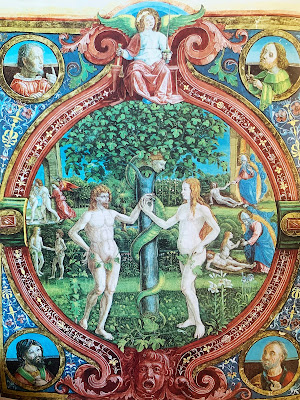Being the main difference between landscape and garden the visual extents (less or more limited) on land, I will use the words alternatively. Where the limit is, can be discussed, as I read in Garden Design and Architects' Gardens (1)
"Sir C. Barry's idea was that the garden was gradually to become less and less formal till it melted away into the park. Compromises such as these, however, will be rejected by thoroughgoing adherents of the formal gardens who hold that the garden should be avowedly separated from the adjacent country by a clean boundary line, a good high wall for choice. (The Formal Garden.)"
Then the author discusses the absurdity of walls for important estates in defense of a soft transition.
"There are many places in every county that would be robbed of their best charms by separating the garden from the adjacent country by a "good high wall."
The custom of planting avenues and cutting straight lines through the woods surrounding the house to radiate in all directions was a departure from that strictly logical system which separated the garden from the park, and left the latter to take care of itself, a system which frankly subordinated Nature to art within the garden wall, but in return gave Nature an absolutely free hand outside it. (The Formal Garden.)"
But, the mere idea of allowing Nature a free hand without human intervention, is impossible in the author's mind, considering in term of a generation there would be little to see.
And here it comes, the reference to the built environment, which I extend to "inbuilt".
Per definition, "inbuilt" means an original, an essential part of something or someone.
Many cultures believe that a primal substance precedes the creation of the man, which in turn becomes part of the environment, a Paradise, the Cosmos, you name it. As an example, for modern people a rock is just a rock; for original peoples (aborigines), a rock can represent the art of creation. (2). In consequence, the environment should also be part of our awareness, beyond the limits of landscape view, where there is no aesthetics but cultural and personal perceptions. Though humans have a common pursuit of beauty. Or inner beauty? Or even love and fertility.
To illustrate this innate connection we have with Nature, I am sharing a picture of a miniature of Adam and Eve, Florence. From the book "The Power of Myth" by Joseph Campbell with Bill Moyers.
A garden is not an ornament of the house. I intend to strengthen here the dialectics between inside and outside, without forcing the geometries, but having a fluid space where the garden or landscape participates of the house interior space as well, bringing home, wilderness, the sacred, and cultivation evolving together.
(1) W. Robinson (London, 1892):
https://www.gutenberg.org/files/37607/37607-h/37607-h.htm
(2) Sacred Earth. Arthur Versluis. p. 19, 1992.








No comments:
Post a Comment